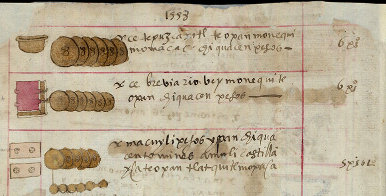amolli Caxtillan (CST18)
This painting of the simplex glyph for the term amolli Castillan (Castile soaps) shows two pinkish rectangles, presumably bars of soap that were imported from Spain or made in that style. Each bar has two small circles, seemingly a design that is pressed into the bar. They could be roses, but they have a quincunx shape. These two bars of soap cost the community five pesos and six tomines, and they were intended for use in cleaning religious objects in the church.
Stephanie Wood
Castile soap is an olive-oil-based hard soap that was developed in sixteenth-century Spain. It is still made and used by some people around the globe. For more on the Codex Sierra, see Kevin Terraciano’s study (2021). In this collection, we have at least two examples of indigenous soap (amolli). See below.
Stephanie Wood
amoli castillā
amolli Caxtillan
Stephanie Wood & Jeff Haskett-Wood
1550–1564
Jeff Haskett-Wood
jabón, barras españolas

amol(li), soap derived from a plant root, https://nahuatl.wired-humanities.org/content/amolli
Caxtillan, Castile, a kingdom of Spain in the sixteenth century, https://nahuatl.wired-humanities.org/content/caxtillan
barras de jabón de Castilla
Stephanie Wood
Códice Sierra-Texupan, plate 18, page dated 1558. Origin: Santa Catalina Texupan, Mixteca Alta, State of Oaxaca. Kevin Terraciano has published an outstanding study of this manuscript (Codex Sierra, 2021), and in his book he refers to alphabetic and “pictorial” writing, not hieroglyphic writing. We are still counting some of the imagery from this source as hieroglyphic writing, but we are also including examples of “iconography” where the images verge on European style illustrations or scenes showing activities. We have this iconography category so that such images can be fruitfully compared with hieroglyphs. Hieroglyphic writing was evolving as a result of the influence of European illustrations, and even alphabetic writing impacted it.
https://bidilaf.buap.mx/objeto.xql?id=48281&busqueda=Texupan&action=search
The Biblioteca Digital Lafragua of the Biblioteca Histórica José María Lafragua in Puebla, Mexico, publishes this Códice Sierra-Texupan, 1550–1564 (62pp., 30.7 x 21.8 cm.), referring to it as being in the “Public Domain.” This image is published here under a Creative Commons license, asking that you cite the Biblioteca Digital Lafragua and this Visual Lexicon of Aztec Hieroglyphs.




